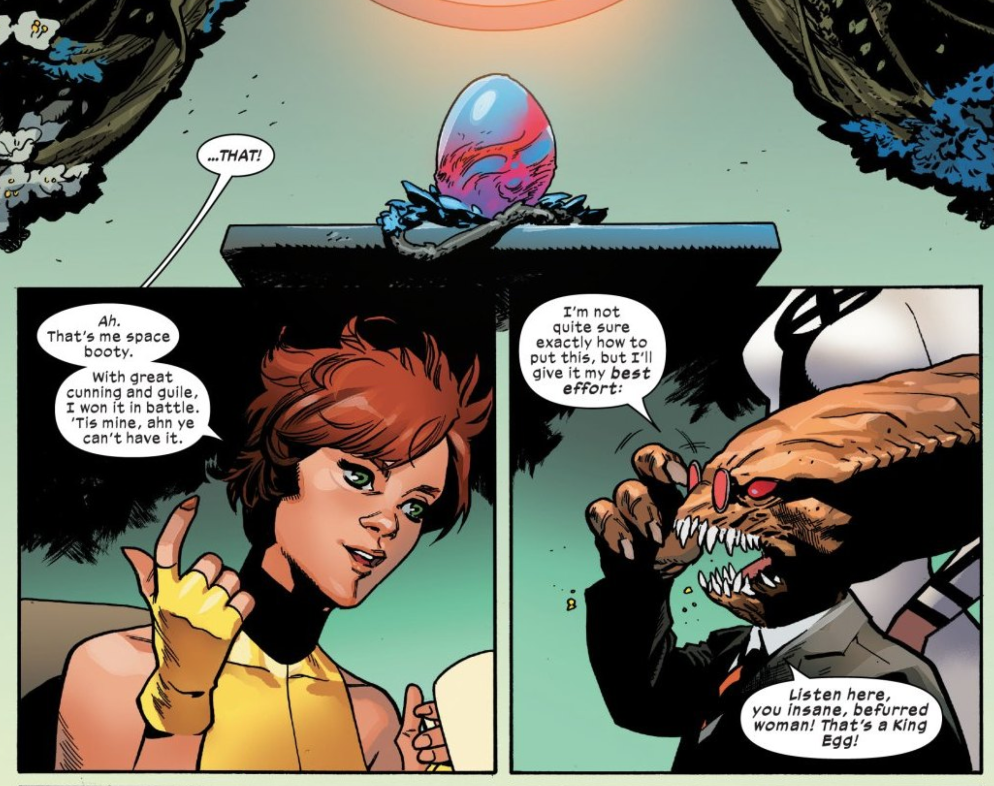Fire
“Fire”
X-Men #10
Written by Jonathan Hickman
Art by Leinil Francis Yu
Color art by Sunny Gho
Vulcan has been a regular supporting character through Jonathan Hickman’s run on X-Men so far, largely played as an overly serious foil to more established characters – his biological brothers Cyclops and Havok, and his new housemate Wolverine. Vulcan is a tricky character who was introduced in Ed Brubaker’s mid-2000s run as a complicated retcon: He’s the lost Summers brother, he was chosen by Charles Xavier and Moira McTaggert to lead a doomed team of forgotten X-Men on a mission to Krakoa, he went off to space to become a tyrannical Shi’ar emperor. There’s even more to it than that, but mostly in “cosmic” Marvel books I have never read. There’s a lot of reasons many reasonable writers would run screaming from this extremely convoluted character, particularly as he’s never had much of a compelling personality beyond spite and madness, but given how much of Hickman’s X-Men hinges on the intersection of Xavier, McTaggert, and Krakoa – not to mention Cyclops being a lead character – he’s sorta cornered into dealing with him and his now-resurrected lost X-Men.
“Fire” does not call back to the part of Vulcan’s story that intersects with Moira and Krakoa, but it does properly reintroduce Petra and Sway – though really, given how little they’ve ever appeared as living characters, it’s more like a regular introduction. Of the four lost X-Men that Brubaker introduced in X-Men: Deadly Genesis, these are the two who died on Krakoa. (Darwin, who appeared as part of the trio who disappeared into The Vault in issue #5, survived the experience and was featured as a member in Brubaker’s Uncanny X-Men run.) Petra and Sway are depicted as rather messy hedonists intent to drink heavily and get wild at the Summers House on the moon while the “boring mutants” are off on vacation. They come across as cheerful types who are not particularly bothered to be residents of a living island that once killed them both. Resurrection seems to have a way of making people very forgiving about such things.
The issue mainly boils down to Vulcan encountering a group of invading aliens connected to the Empyre crossover event and them tampering with his mind, seeing his reborn and stable form as a broken version of him, and introducing a corrupting element that will undermine his progress and redemption. This sets Vulcan up for an eventual return to his primary role as an antagonist, most likely whenever Hickman’s ongoing Shi’ar story kicks into high gear. The interesting part of this development is more that Vulcan’s story becomes about him knowing this has happened and actively resisting the lure towards madness and destruction.
Hickman has put a lot of effort into putting the traditional X-Men mutant villains on paths towards antagonistic roles without undermining the notion of Krakoa unifying all the mutants. House of X set Sabretooth up for an eventual revenge story after he was cruelly imprisoned by the Quiet Council, and Powers of X set in motion some grand betrayal by Mister Sinister as part of establishing the resurrection protocols. Exodus appears to be on a path towards cultish zealotry in parallel with Nightcrawler’s creation of a mutant religion, and it looks like we’re set to discover Apocalypse’s true motives in X of Swords. And then there’s Mystique, who will undermine the Quiet Council as she seethes in fully justified resentment of being denied the resurrection of her wife Destiny. It’s pretty clear that once the Mystique/Destiny/Moira plot comes into play, we’ll be entering the end game of this whole thing.
Vulcan’s trajectory is an interesting counterpoint to that of Mystique. Both are former enemies playing at being reformed members of Krakoan society, but whereas Mystique is only playing along to advance her personal agenda, Vulcan seems to genuinely want to be a better man and live up to the example of his brothers. Mystique embraces the moral rot in her, and her capacity for causing chaos, but Vulcan now lives in fear of this destructive element in him. Even before the alien intervention he knew he was a bomb waiting to go off – now he’s stuck worrying that he is powerless to defuse it. As with the other mutant villains set on a track to return to form, his plight is very true to the core of his character and is driven by relatable motives. The difference is that he’s the character positioned to overcome his worst impulses.
Some notes:
• It’s hard not to notice how between Hickman’s X-Men, Gerry Duggan’s Marauders, Ed Brisson’s New Mutants, and Benjamin Percy’s X-Force there is a real obsession with showing X-Men drinking heavily, with a few characters being depicted as problem drinkers. It’s a little weird, and I imagine it must grate on sober readers quite a bit.
• I love that Hickman has made elements of Ed Brubaker and Mike Carey’s parallel mid-’00s X-Men comics very crucial to his own work, while virtually nothing from Joss Whedon’s much more popular concurrent Astonishing X-Men series has come into play. But of course – Whedon’s take was deliberately retro, and he didn’t actually add much to franchise in terms of big ideas. (But hey, Armor has showed up, so that’s something.)





